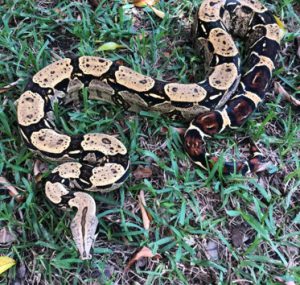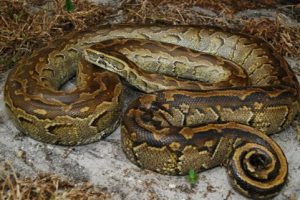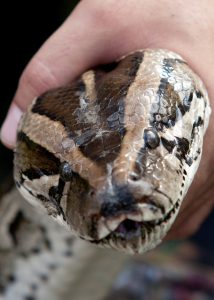FORT LAUDERDALE, Fla – Non-native snakes in Florida are spreading and growing in population.
Some are considered invasive, threatening Florida’s environment, native wildlife, economy and public health, according to scientists at the University of Florida Institute of Food and Agricultural Sciences (UF/IFAS).

While residents need to be on the lookout for non-native snakes, it can be easy to misidentify them or confuse them with native species. That’s why the Croc Docs, a team of scientists at UF/IFAS Fort Lauderdale Research and Education Center, have published Large Snake Lineup for South Florida: A guide to differentiating between non-native and native snakes in partnership with the South Florida Water Management District (SFWMD). This collaboration is part of a larger initiative to increase detection, reporting and removal of non-native snakes through targeted outreach with public involvement.
The guide includes photos and descriptions of eight key high-risk, non-native snakes and five native snakes. It is one of several tools residents can use to help scientists gather information about the status of these non-native snakes.
“To remove an invasive snake, you first have to detect it, and we are seeking assistance from the public to address the need for more eyes on the ground,” said Melissa Miller, invasive species research coordinator for Croc Docs. “This guide will help the public to identify and report non-native snakes in Florida, as well as to distinguish these snakes from several species of native Florida snakes commonly misidentified as non-native.”
Residents who spot invasive snakes can report and submit photos through the 1-888-IVEGOT1 hotline and through a smartphone app and website of the same name, Ivegot1.org.
Native snakes can be found in every habitat and are an essential part of the ecosystem. Many native snakes directly benefit humans by reducing rodent populations, resulting in healthy crops and less disease. They also maintain balance in the food web because they are both predator and prey items for native wildlife.

“Invasive large constrictor snakes, such as the Burmese python, pose a serious threat to Florida’s native wildlife,” said Miller. “Pythons are responsible for severe declines of local mammal populations in the Everglades and these snakes appear to target wading bird colonies, threatening at-risk species by predation. Meanwhile, pythons have also introduced an Asian lung parasite, which now infects many Florida snakes.”
Distinguishing native and non-native snakes can be difficult, making this resource all the more important. For example, due to its large size, the native eastern indigo snake is a glossy black snake with a rust orange color under its head that has been often confused with a non-native constrictor. Corn snakes and young racers are sometimes confused with hatchlings of pythons. Also, brown water snakes are often confused for pythons due to their choice of aquatic habitat, large adult size and blotched pattern.
“Identification is vital when reporting invasive species, as we want to ensure that our native snakes can thrive and not be disturbed,” said Miller.

The non-native species described in the fact sheet include the common boa constrictor and the North African python, which are both established in Miami-Dade County. The Burmese python has established in Miami-Dade and several other counties across the Everglades region. Common boa constrictors have been introduced in many counties, including Broward and Hillsborough counties.
Other non-native species kept as pets, such as the reticulated python, ball python, green anaconda, yellow anaconda and Dumeril’s boa, may pose a threat to native species if they become established in Florida. This is why pet owners are asked not to release snakes and other reptiles into the wild.
Non-native snakes are commonly encountered on roads and levees. They leave long drafts of dust and mud that may not be easy to see. Non-native pythons can be found almost anywhere, so it is important to be vigilant. Often found near water sources including swamps, marshes or open fields, python also appear in urban areas, where they been seen in garages, on boats, in front yards and crossing high traffic roads.
“We need the public’s help to contain established species such as Burmese pythons and to prevent the establishment of new species,” said Frank Mazzotti, a UF/IFAS professor of wildlife ecology affiliated with the Croc Docs. “Be on the lookout for nonnative snakes and if you see one, take a picture and report it to the 1-888-IVE-GOT1 hotline, on the app or website.
-30-
By Lourdes Mederos, rodriguezl@ufl.edu
The mission of the University of Florida Institute of Food and Agricultural Sciences (UF/IFAS) is to develop knowledge relevant to agricultural, human and natural resources and to make that knowledge available to sustain and enhance the quality of human life. With more than a dozen research facilities, 67 county Extension offices, and award-winning students and faculty in the UF College of Agricultural and Life Sciences, UF/IFAS brings science-based solutions to the state’s agricultural and natural resources industries, and all Florida residents.
ifas.ufl.edu | @UF_IFAS
 1
1
